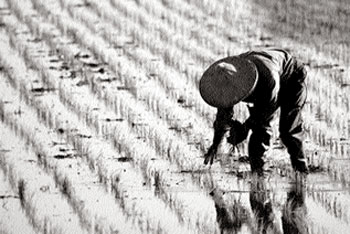
Origins of rice point to China
Rice originated in China, a team of genome researchers has concluded
in a study tracing back thousands of years of evolutionary history
through large-scale gene re-sequencing. Their findings, which appear in
the latest issue of the Proceedings of the National Academy of Sciences
(PNAS), indicate that domesticated rice may have first appeared as far
back as approximately 9,000 years ago in the Yangtze Valley of China.
Previous research suggested domesticated rice may have two points of
origin -- India as well as China.
The study was conducted by researchers from New York University's
Center for Genomics and Systems Biology and its Department of Biology,
Washington University in St. Louis' Department of Biology, Stanford
University's Department of Genetics, and Purdue University's Department
of Agronomy.Asian rice, Oryza sativa, is one of world's oldest crop
species. It is also a very diverse crop, with tens of thousands of
varieties known throughout the world.

Two major subspecies of rice -- japonica and indica -- represent most
of the world's varieties. Sushi rice, for example, is a type of
japonica, while most of the long-grain rice in risottos are indica.
Because rice is so diverse, its origins have been the subject of
scientific debate. One theory -- a single-origin model -- suggests that
indica and japonica were domesticated once from the wild rice O.
rufipogon.Another -- a multiple-origin model -- proposes that these two
major rice types were domesticated separately and in different parts of
Asia.
The multiple-origin model has gained currency in recent years as
biologists have observed significant genetic differences between indica
and japonica, and several studies examining the evolutionary
relationships among rice varieties supported more than domestication in
both India and China.In the PNAS study, the researchers re-assessed the
evolutionary history, or phylogeny, of domesticated rice using
previously published datasets, some of which have been used to argue
that indica and japonica rice have separate origins.
Using more modern computer algorithms, however, the researchers
concluded these two species have the same origin because they have a
closer genetic relationship to each other than to any wild rice species
found in either India or China.In addition, the study's authors examined
the phylogeny of domesticated rice by re-sequencing 630 gene fragments
on selected chromosomes from a diverse set of wild and domesticated rice
varieties. Using new modeling techniques, which had previously been used
to look at genomic data in human evolution, their results showed that
the gene sequence data was more consistent with a single origin of
rice.In their PNAS study, the investigators also used a "molecular
clock" of rice genes to see when rice evolved. Depending on how the
researchers calibrated their clock, they pinpointed the origin of rice
at possibly 8,200 years ago, while japonica and indica split apart from
each other about 3,900 years ago.
The study's authors pointed out that these molecular dates were
consistent with archaeological studies. Archaeologists have uncovered
evidence in the last decade for rice domestication in the Yangtze Valley
beginning approximately 8,000 to 9,000 years ago while domestication of
rice in the India's Ganges region was around about 4,000 years ago."
As rice was brought in from China to India by traders and migrant
farmers, it likely hybridised extensively with local wild rice,"
explained NYU biologist Michael Purugganan, one of the study's
co-authors.
"So domesticated rice that we may have once thought originated in
India actually has its beginnings in China".
-Science Daily |

